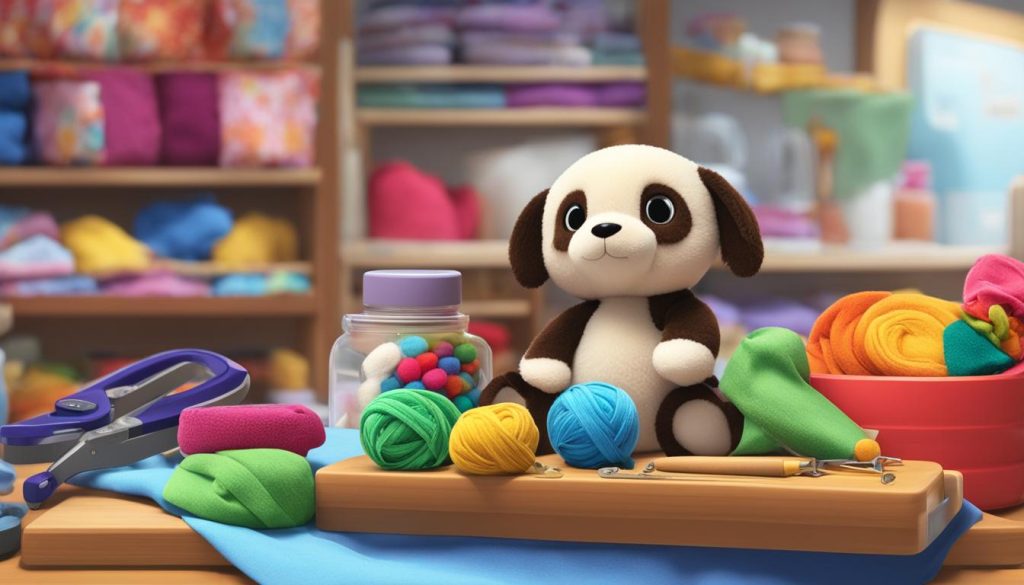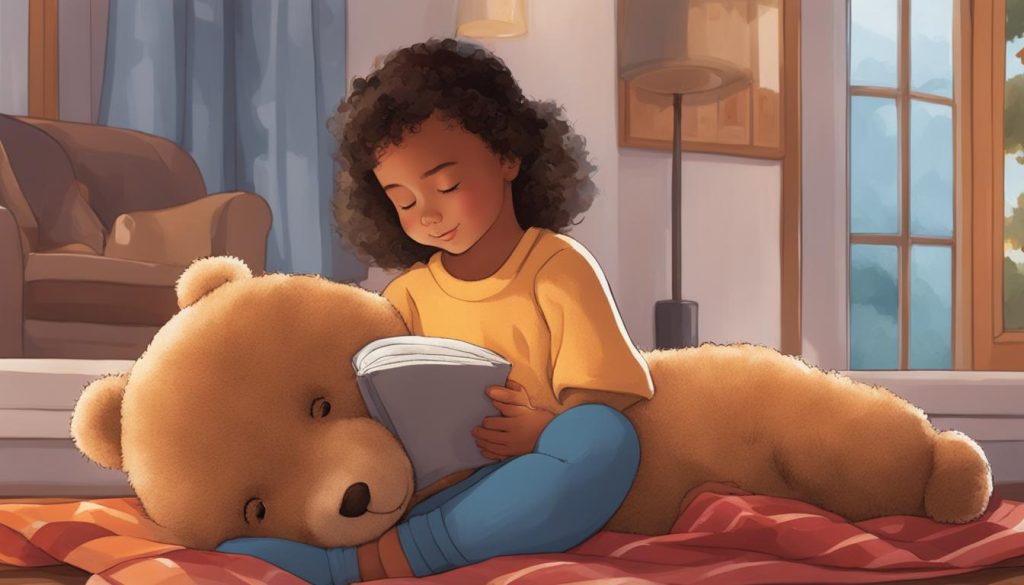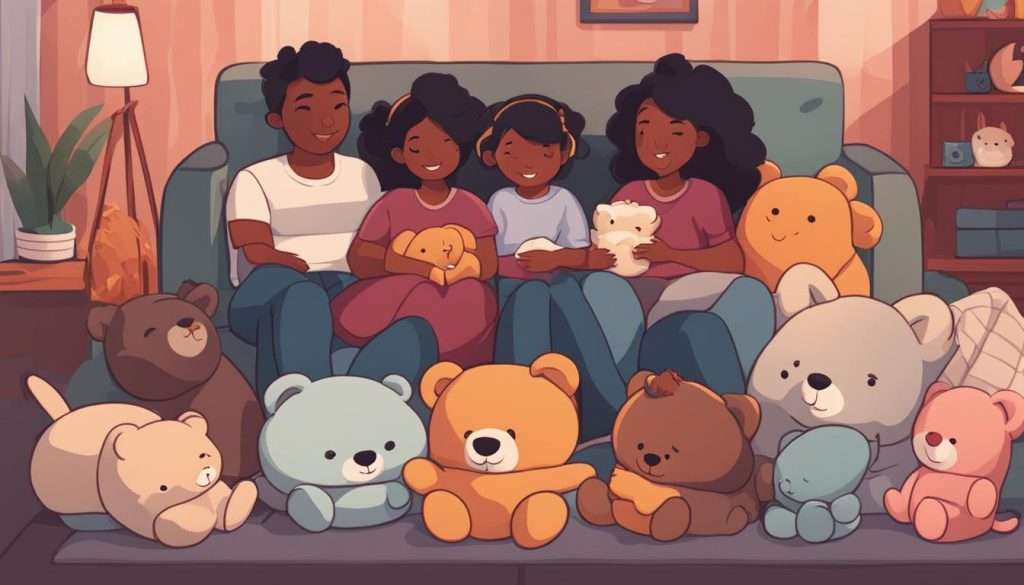Are you looking for a new and unique project? Why not try making a weighted stuffed animal? This comprehensive guide will provide you with a step-by-step process and valuable tips to help you create your own personalized weighted stuffed animal.
From gathering materials to sewing and filling, follow these instructions to make a high-quality and comforting companion. Whether you’re making it for yourself or as a gift, this guide has got you covered.
When it comes to creating your own weighted stuffed animal, the possibilities are endless. Let’s dive into the world of DIY weighted stuffed animals and explore how you can bring your imagination to life.
In this tutorial, you will learn:
- How to gather materials for your homemade weighted stuffed animal
- The step-by-step process of removing the original stuffing and sewing bean bags
- Choosing the perfect weighted filling material
- Tips for filling your stuffed animal with weighted materials and sewing up the seams
By the end of this guide, you’ll have the knowledge and confidence to create your very own personalized weighted stuffed animal. Let’s get started!
Therapeutic Benefits of Weighted Stuffed Animals for Children with Sensory Needs
Weighted stuffed animals offer a range of therapeutic benefits for children with sensory needs, including those with autism, anxiety, sensory processing disorders, and ADHD. The gentle pressure and deep touch stimulation provided by the weighted filling can have a calming effect on the nervous system, promoting relaxation and reducing anxiety levels.
These specially designed stuffed animals can also aid in improving focus and attention. The added weight can help children with sensory needs to feel more grounded and centered, facilitating sensory integration and self-regulation. By providing a comforting and soothing sensory tool, weighted stuffed animals can assist children in managing sensory overload and promoting a sense of security.
“Weighted stuffed animals have been shown to be incredibly beneficial for children with sensory needs. The additional weight and tactile input can help these children feel more secure and calm, reducing their anxiety and promoting better focus and engagement.”
Additionally, weighted stuffed animals can provide a sense of companionship and comfort, acting as a source of emotional support for children. The soft and cuddly nature of these animals can offer a tactile and soothing experience, helping children feel safe and secure.
| Therapeutic Benefits: | Conditions: |
|---|---|
| Reduces anxiety | Anxiety disorders, autism |
| Promotes relaxation | Sensory processing disorders, ADHD |
| Improves focus and attention | Anxiety, ADHD |
| Aids in sensory integration | Sensory processing disorders, autism |
| Provides emotional support | Anxiety disorders, autism |
Creating a weighted stuffed animal allows you to tailor it specifically to your child’s needs, ensuring an ideal weight and texture. These therapeutic companions can make a significant difference in the lives of children with sensory needs, providing comfort, support, and a tool for self-regulation.
Types and Features of Weighted Stuffed Animals
When it comes to making a weighted stuffed animal, there are various types and features to consider. The type of fabric used for the body of the animal can range from soft and cuddly materials to more durable and textured fabrics. The choice of fabric will depend on factors such as the desired look and feel of the stuffed animal, as well as its intended use. It’s important to select a fabric that is both comfortable and safe for the intended user.
Another important feature to consider is the filling material. Weighted stuffed animals can be filled with a variety of materials, each with its own unique characteristics. Popular options include poly-pellets, plastic, hemp, wool, leather, and foam. The choice of filling material will impact the weight and texture of the stuffed animal, as well as its overall comfort. It’s essential to choose a filling material that is safe, hypoallergenic, and suitable for the intended user.
In addition to fabric and filling material, having a sewing machine or needle and thread is necessary for assembly. A sewing machine can make the process faster and more efficient, especially for larger projects. However, if you don’t have access to a sewing machine, a needle and thread can still be used to hand-sew the stuffed animal. Regardless of the method chosen, it’s important to ensure that all seams are securely stitched to prevent any leakage of the weighted filling material.
| Type of Fabric | Filling Material | Assembly |
|---|---|---|
| Soft and cuddly materials | Poly-pellets, plastic, hemp, wool, leather, foam | Sewing machine or needle and thread |
| Durable and textured fabrics |
When creating a weighted stuffed animal, it’s important to follow safety guidelines. This includes using child-friendly materials that are free from any harmful substances. Additionally, securely stitching all seams and openings is crucial to prevent any weighted filling from leaking out. Proper weight distribution is also essential to ensure that the stuffed animal is balanced and comfortable for the child. By considering these types and features, as well as adhering to safety guidelines, you can create a high-quality and safe weighted stuffed animal.
Safety Guidelines for Weighted Stuffed Animals
When creating a weighted stuffed animal, it’s crucial to prioritize safety to ensure that it can be enjoyed without any potential harm. Consider the following safety guidelines to create a child-friendly and secure weighted companion:
- Choose child-friendly materials: Select fabrics that are soft, hypoallergenic, and free from any harmful substances. Make sure to check for any potential allergens or choking hazards in the chosen materials.
- Secure stitching: Use strong and durable stitching techniques to ensure that the seams of the stuffed animal are securely closed. This will prevent any weighted filling from escaping and posing a risk to young children.
- Proper weight distribution: It’s important to distribute the weight evenly throughout the stuffed animal to maintain balance and comfort. Uneven weight distribution could lead to discomfort or strain on specific areas, so take care to distribute the weighted filling evenly.
“Safety should always be a priority when creating a weighted stuffed animal. Choose child-friendly materials, secure the stitching, and ensure proper weight distribution.” – DIY Stuffed Animals Magazine
By following these safety guidelines, you can create a weighted stuffed animal that not only provides sensory support but also ensures the well-being of the child. Remember to regularly inspect the stuffed animal for any signs of wear and tear and repair or replace it as needed to maintain its safety and effectiveness.
Now that you have a good understanding of the safety guidelines for weighted stuffed animals, let’s move on to the next section to learn how to choose the perfect weighted companion for your child.
How to Choose a Weighted Stuffed Animal for Your Child
When it comes to choosing a weighted stuffed animal for your child, there are a few important factors to consider. By taking into account your child’s preferences, age appropriateness, size, weight, and design, you can select the perfect companion that meets their needs and brings them comfort.
First and foremost, consider your child’s preferences. Think about their favorite colors, animals, or characters, and try to find a weighted stuffed animal that matches their interests. This will make the toy more appealing to them and increase the likelihood that they will form a strong bond with it.
Additionally, it’s crucial to choose a weighted stuffed animal that is age-appropriate. Ensure that the toy does not have any small parts that can pose a choking hazard for younger children. For older children, you may want to consider a larger-sized animal that they can comfortably cuddle with.
The size and weight of the stuffed animal should also be taken into consideration. As a general guideline, it is recommended to choose a stuffed animal that weighs about 10% of your child’s body weight. This will provide the right amount of pressure and sensory input without feeling too overwhelming. Be sure to check the product description or label for the weight of the stuffed animal before making a purchase.
| Age Range | Weight Range |
|---|---|
| 0-2 years | 1-2 lbs |
| 3-5 years | 2-3 lbs |
| 6-9 years | 3-4 lbs |
| 10+ years | 4+ lbs |
Lastly, consider the design of the stuffed animal. Some children may prefer a specific animal or character, while others may have a favorite pattern or texture. Choose a design that resonates with your child and makes them feel connected to their new companion.
By keeping these factors in mind, you can choose a weighted stuffed animal that not only provides the therapeutic benefits your child needs but also brings them joy and comfort.
Step-by-Step Guide to Making Your Own Weighted Stuffed Animal
Creating your own weighted stuffed animal is a rewarding and enjoyable project. Follow this step-by-step guide to bring your personalized companion to life.
Gathering Materials
Before you begin, gather all the materials you will need:
- Fabric for the body of the animal
- Weighted filling material, such as polyester, plastic, hemp, wool, leather, or foam
- Sewing tools, including a sewing machine or needle and thread
Having these materials on hand will ensure a smooth and efficient process.
Removing Original Stuffing
The first step is to remove the original stuffing from the animal’s body. Carefully open the seams and extract the stuffing, making sure to keep the fabric intact.
Tip: It’s best to use a seam ripper or small scissors to remove the stitches without damaging the fabric.
Sewing Bean Bags
If you prefer a more structured weight distribution, you can sew bean bags to hold the weighted filling material. Cut small pieces of fabric and sew them into small pouches. Fill the pouches with the chosen weighted material and securely stitch them closed.
Choosing Weighted Stuffing Material
Next, choose the best weighted stuffing material for your project. Consider the weight, texture, and flexibility of the filling material to ensure comfort and sensory support.
Quote: “The choice of weighted stuffing material depends on personal preference and the desired level of sensory stimulation.” – Weighted Stuffed Animal Enthusiast
Filling with Weighted Materials
Fill the body of the animal with a combination of stuffing and the chosen weighted material. Ensure even distribution throughout the body for balanced weight and comfort.
Sewing Up the Seams
Once the filling is in place, carefully sew up the seams to enclose the weighted materials. Use a strong and secure stitch to prevent any leaks or tears.
Final Touches
Add any final touches to personalize your weighted stuffed animal. This can include adding embellishments, features, or additional stitching for reinforcement.
With the completion of these steps, your homemade weighted stuffed animal is ready to provide comfort and sensory support.
| Materials | Tools |
|---|---|
| Fabric | Sewing machine or needle and thread |
| Weighted filling material (polyester, plastic, hemp, wool, leather, foam) | Scissors or seam ripper |
| Bean bags (optional) | |
| Embellishments (optional) |
Enjoy the Benefits of Your Weighted Stuffed Animal
Now that you have successfully made your own weighted stuffed animal, you can experience the numerous benefits it offers. The weighted filling provides gentle pressure and sensory support, which can help promote relaxation and reduce stress. Whether you have sensory needs, anxiety, or just need some comfort, your weighted stuffed animal can provide the therapeutic value you seek.
One of the significant advantages of a weighted stuffed animal is the improved sleep it can offer. The deep touch stimulation from the weighted filling can help calm the body and mind, leading to a more restful night’s sleep. Feeling the weight of the stuffed animal against your body can provide a sense of security and enhance relaxation, creating an ideal environment for quality sleep.
Aside from the therapeutic benefits, your homemade weighted stuffed animal can offer comfort and companionship. Its soft and cuddly presence can provide a sense of reassurance and serve as a source of emotional support. Whether you’re a child or an adult, having a comforting and reliable companion can make a significant difference in how you cope with stress and anxiety.
Embrace the benefits of your weighted stuffed animal and cherish the comfort and companionship it brings. Whether you use it for sensory support, stress relief, improved sleep, or simply for its therapeutic value, your creation is a testament to your creativity and care. Enjoy the comfort and relaxation that your personalized weighted stuffed animal provides, and let it bring you joy and tranquility.





